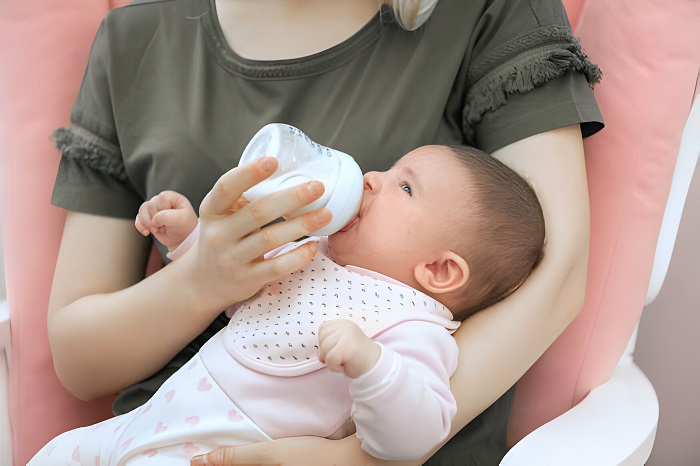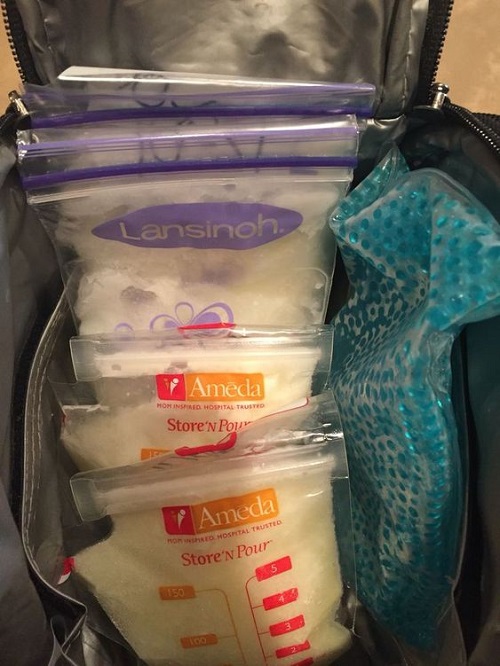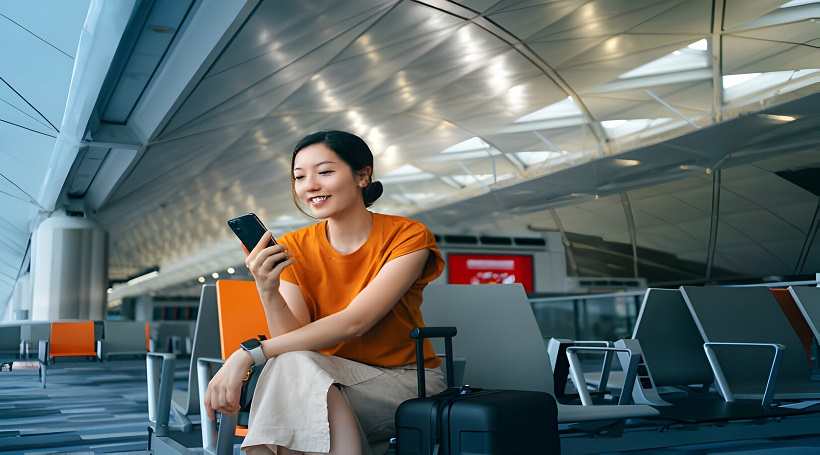Yes, you can travel with breast milk without your baby. However, there are certain regulations to follow when flying with breast milk.
The Transportation Security Administration (TSA) allows you to bring breast milk in quantities greater than 3. 4 ounces in your carry-on bag. Make sure to inform the security officer about the breast milk before they screen your bag. Additionally, it’s advisable to check the specific guidelines of the airline you are traveling with as they may have different rules regarding carrying breast milk.
As long as you comply with the regulations, you can travel with breast milk even without your baby.
Traveling With Breast Milk

Traveling with breast milk without your baby is possible, but there are rules to follow. Ensure you familiarize yourself with TSA guidelines and plan for storage and transportation to make the process smooth and stress-free.
Read More – How Long Breast Milk Can Be Stored Outside?
Traveling with breast milk can be both beneficial and challenging. Breast milk is known to have numerous benefits for babies, providing essential nutrients and antibodies that promote their health and development. However, when it comes to travel, there are several factors to consider, including regulations, storage, and transportation of breast milk. This article will discuss the benefits of breast milk for babies and the challenges faced when traveling with breast milk.
Benefits Of Breast Milk For Babies
Breast milk is a powerhouse of nutrition for babies. It contains the perfect combination of proteins, fats, and carbohydrates, essential for their growth. Additionally, breast milk is rich in antibodies, which help protect babies against illnesses and infections. The unique composition of breast milk is easily digested by infants, reducing the risk of gastrointestinal issues. Research suggests that breastfed babies have a lower risk of developing allergies, asthma, and obesity later in life. Furthermore, the act of breastfeeding fosters bonding between the mother and baby, creating a nurturing and comforting environment.
Challenges Of Traveling With Breast Milk
Traveling with breast milk can pose some challenges for nursing mothers. One of the main challenges is adhering to the different regulations set by airlines and security checkpoints. It is crucial to familiarize yourself with these regulations beforehand to ensure a smooth travel experience. Another challenge is storing and transporting breast milk while keeping it safe and hygienic. Breast milk needs to be stored at a specific temperature to maintain its quality and nutritional value. Traveling long distances or in areas with limited access to refrigeration can be problematic. Additionally, carrying excess breast milk can add extra weight and bulk to your luggage.
To overcome these challenges, it is important to plan and be well-prepared. Here are some tips for traveling with breast milk:
1. Research airline policies and security regulations regarding the transportation of breast milk. Some airlines may have specific guidelines on quantities allowed and packaging requirements.
2. Invest in a quality breast milk cooler bag or insulated container to keep the milk cold during travel. Consider using ice packs or frozen gel packs to maintain the temperature.
3. Pack breast milk storage bags or containers that are leak-proof and sterilized to ensure proper hygiene.
4. If you are traveling internationally, familiarize yourself with customs and immigration regulations regarding the importation of breast milk.
5. If possible, try to nurse or pump right before your flight to minimize the amount of milk you need to carry during the journey.
6. If you need to pump during your travel, consider using a portable, battery-operated breast pump for convenience.
7. If you are staying at a hotel or accommodation, check if they can provide a refrigerator or freezer for storing your breast milk.
Remember, the health and well-being of your baby should always come first. With proper planning and preparation, traveling with breast milk can be manageable, allowing you to provide your baby with the best possible nutrition even on the go.
Read More – Can Mother’s Diet Cause Baby Diarrhea?
Transporting Breast Milk
Transporting breast milk without a baby may seem like an unusual prospect, but it’s a common concern for nursing mothers. Whether for work-related travel, donation, or storage, knowing the best practices for transporting breast milk is essential. Understanding the federal guidelines, proper packing, and labeling are crucial for a smooth and worry-free journey.
Federal Guidelines For Transporting Breast Milk
When traveling with breast milk, it’s important to adhere to federal guidelines to ensure its safety and legality. According to the Transportation Security Administration (TSA), breast milk is exempt from the 3.4-ounce liquid limit for carry-on bags. However, it is subject to additional screening. Informing the security officer about the breast milk during the screening process can help expedite the procedure.
Packing And Labeling Breast Milk For Travel
Proper packing and labeling are essential when transporting breast milk. Using sturdy containers such as breast milk storage bags or BPA-free bottles is recommended. Seal the containers securely, and consider double-bagging to prevent leaks. Labeling each container with the date of expression is crucial for maintaining freshness and compliance with regulations.
Types Of Travel Allowed For Breast Milk
Breast milk is precious, and for many mothers, it’s essential to be able to travel with it. Whether you’re going on a business trip, taking a vacation, or just need to transport your breast milk from one place to another, understanding the types of travel allowed for breast milk is crucial.
Air Travel
Air travel offers many conveniences but can also pose a challenge for mothers who need to transport breast milk. To travel with breast milk by air, there are a few important rules to keep in mind. It’s allowed to bring breast milk in quantities greater than 3.4 ounces through airport security. It’s recommended to inform the TSA officers about the breast milk to avoid any delays during the security check. Ensure that the breast milk is packed in a clear, sealable bag for inspection.
Train And Bus Travel
For mothers traveling with breast milk on trains or buses, the guidelines are generally more flexible. You can carry breast milk in your carry-on baggage or a separate cooler, and you may be required to have it inspected at security checkpoints. It’s advised to check the specific rules and regulations of the train or bus company you’re using, as they may have their policies regarding transporting breast milk.
Car Travel
When it comes to traveling with breast milk by car, the options are more flexible. You can easily transport breast milk in a cooler or insulated bag, making stops as needed to ensure it stays at the appropriate temperature. If traveling long distances, consider using ice packs or a portable cooler to keep the breast milk fresh and safe during the journey.
Read More – Can Mother’s Diet Cause Constipation In Breastfed Baby?
Tips For Traveling With Breast Milk
Traveling with breast milk can be a challenging task, but with proper planning and organization, it can become a seamless experience. Whether you are a working mom who needs to pump and store milk for your baby while on a business trip, or you simply want to ensure a ready supply of breast milk while traveling without your baby, these tips will help you navigate the process with confidence.
Planning Ahead
Proper planning is key when traveling with breast milk. Make sure to research the guidelines and regulations of your airline and destination beforehand. Knowing the rules and requirements will help you avoid any surprises or issues during your journey. Here are some points to consider:
- Check if the airline allows the transportation of breast milk in your carry-on luggage.
- Be aware of any limitations on the volume of breast milk that you can bring on board.
- If you are traveling internationally, familiarize yourself with the customs requirements and restrictions regarding the transportation of breast milk.
- Consider bringing a small cooler bag or insulated container to keep the breast milk at the right temperature during transit.
- Plan your pumping schedule based on your travel itinerary to ensure a steady supply of breast milk.
Choosing The Right Containers
When packing breast milk for your journey, selecting the right containers is crucial to maintain its quality and freshness. Here are some tips:
- Use breast milk storage bags or containers that are specifically designed for this purpose. These containers are typically leak-proof and freezer-safe.
- Ensure that the containers are clean and sanitized before filling them with breast milk. This will prevent contamination and maintain its safety.
- Label each container with the date and time of expression. This will help you keep track of the freshness of the milk.
- If you are packing frozen breast milk, ensure that the containers are well-sealed and placed in a sturdy, leak-proof bag to prevent thawing during transit.
Freezing Vs. Refrigerating Breast Milk
Deciding whether to freeze or refrigerate breast milk for your travels depends on various factors, including the duration of your trip and the availability of suitable storage facilities. Here’s what you need to know:
| Freezing Breast Milk | Refrigerating Breast Milk |
|---|---|
| Freezing breast milk allows for longer storage, which is ideal for extended trips. | Refrigerating breast milk is suitable for shorter trips when it can be consumed within a few days. |
| Ensure the breast milk is properly sealed and stored in a freezer-safe container. | Keep the breast milk in a refrigerator with a temperature of 39°F (4°C) or lower. |
| Thaw frozen breast milk in a refrigerator to maintain its quality. | Refrigerated breast milk can be kept at room temperature for up to four hours. |
| Consider using dry ice if you need to transport frozen breast milk over an extended period. | Ensure the refrigerator compartment of your travel accommodation is working properly before storing the breast milk. |
By following these tips, you can travel with breast milk confidently, ensuring a safe and convenient supply for your baby even when you are not together.
Legal Considerations When Traveling Without The Baby
The legal considerations when traveling without the baby are essential to understand to ensure a smooth journey. Various laws and regulations, as well as protocols for notifying security and customs, need to be taken into account. This article explores these aspects and provides comprehensive information on how to travel with breast milk without the baby.
Laws And Regulations
When it comes to traveling without the baby, it’s crucial to be aware of the laws and regulations surrounding transporting breast milk. Each country may have its own guidelines, so it’s essential to do thorough research beforehand.
Here are some key points related to laws and regulations:
- Check the laws of both your departure and destination countries to ensure compliance.
- Some countries may have restrictions on the amount of breast milk you can carry, while others may require specific documentation.
- Keep in mind that laws can change, so staying up-to-date is essential. Check official government websites or consult with your airline for the most recent information.
- Consider carrying a copy of relevant laws or regulations with you to show authorities if needed.
Notifying Security And Customs
When traveling without the baby, it’s crucial to notify security and customs officials about the presence of breast milk. This notification is vital to ensure a smooth and hassle-free screening process. Here are some tips on how to notify security and customs:
Notifying Security:
- Inform the security personnel at the beginning of the screening process about the presence of breast milk.
- Place the breast milk in a separate bag and let them know that you are carrying it.
- Be prepared for additional screening, such as having the breast milk tested for security purposes.
Notifying Customs:
- Declare your breast milk to customs officials upon arrival in a foreign country, if necessary.
- Ensure you have all the required documentation, such as a doctor’s note or proof of intent to breastfeed.
- Be ready to answer any questions or provide additional information if requested by customs.
By following these procedures and guidelines, you can navigate the legal considerations of traveling without the baby and ensure a stress-free journey. Remember to stay informed, be prepared, and notify the relevant authorities to make your trip as smooth as possible.

Frequently Asked Questions On Can You Travel With Breast Milk Without Baby?
Can You Travel With Breast Milk Without Baby?
Yes, you can travel with breast milk without your baby. These guidelines can help you do it safely and conveniently.
How Do You Travel With Breast Milk?
To travel with breast milk, use insulated bags with ice packs or dry ice. Place the bags in your carry-on luggage to keep the milk chilled.
How Long Can You Travel With Breast Milk?
Breast milk can be safely stored for up to 24 hours in an insulated bag with ice packs or up to 72 hours with dry ice. Check with your airline for specific guidelines.
Do You Need A Prescription To Travel With Breast Milk?
No, you do not need a prescription to travel with breast milk. However, carry a letter from your healthcare provider stating the medical need for it.
Can You Bring Breast Milk On A Plane?
Yes, you can bring breast milk on a plane. It is exempt from the usual liquid restrictions, but it’s recommended to inform the security officer beforehand.
Conclusion
Traveling with breast milk without the baby can be a daunting task, but it is certainly possible with proper planning and preparation. By following the TSA guidelines, using insulated cooler bags or portable breast milk storage containers, and being aware of the specific airline rules, mothers can confidently transport their breast milk while ensuring its safety and integrity.
It is important to stay informed and knowledgeable about the necessary procedures to make this process as smooth as possible. Safe travels!







